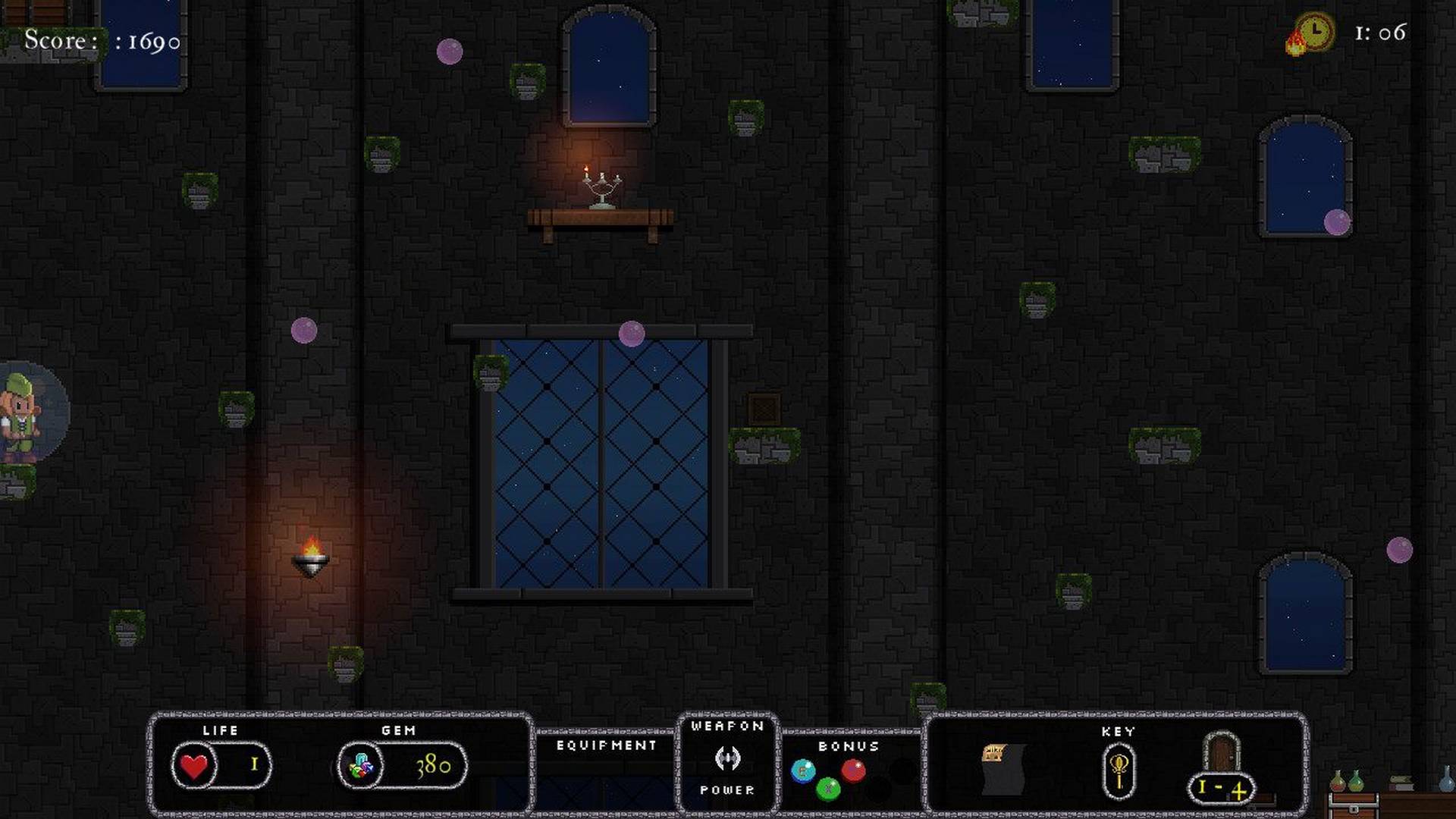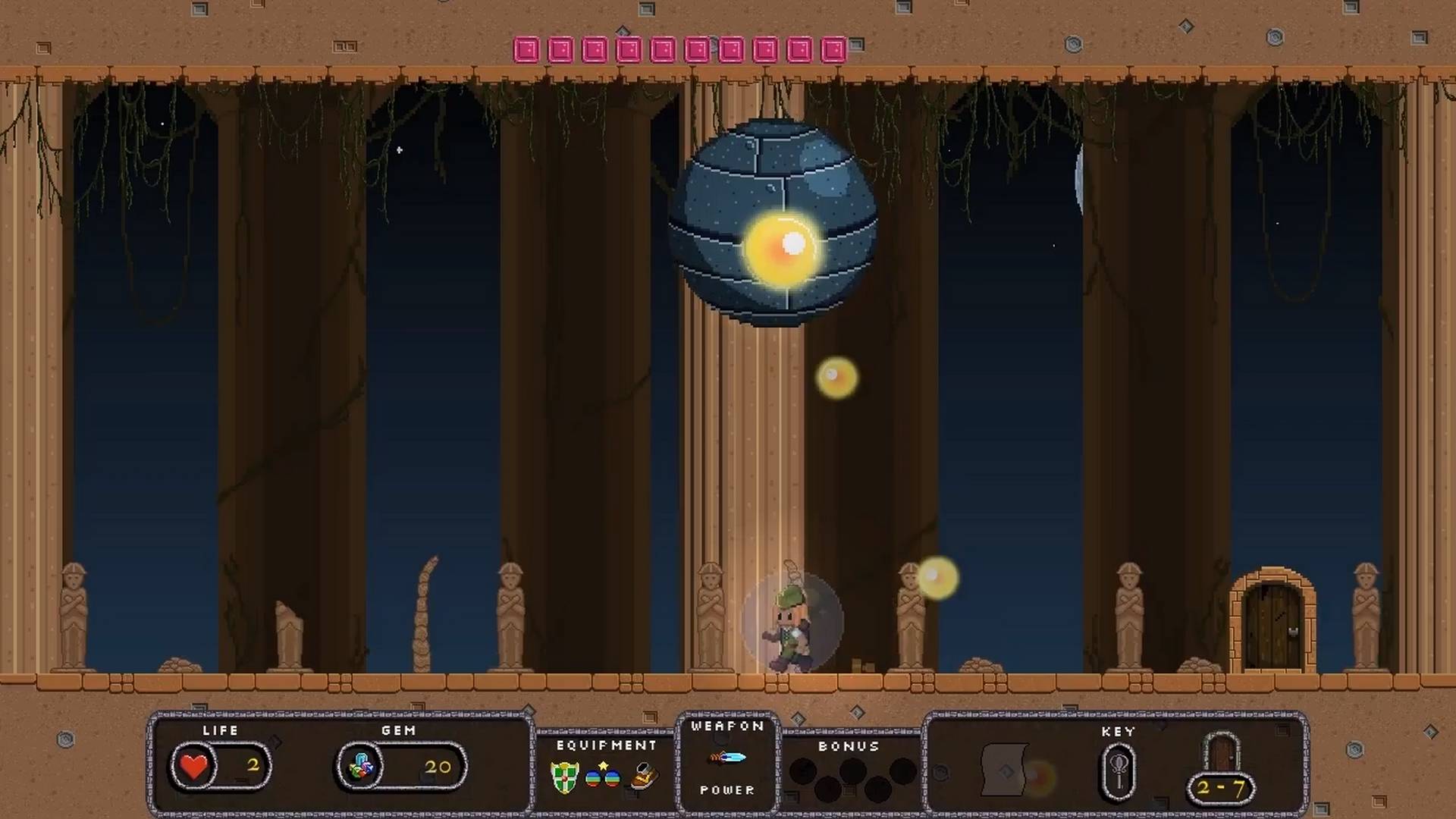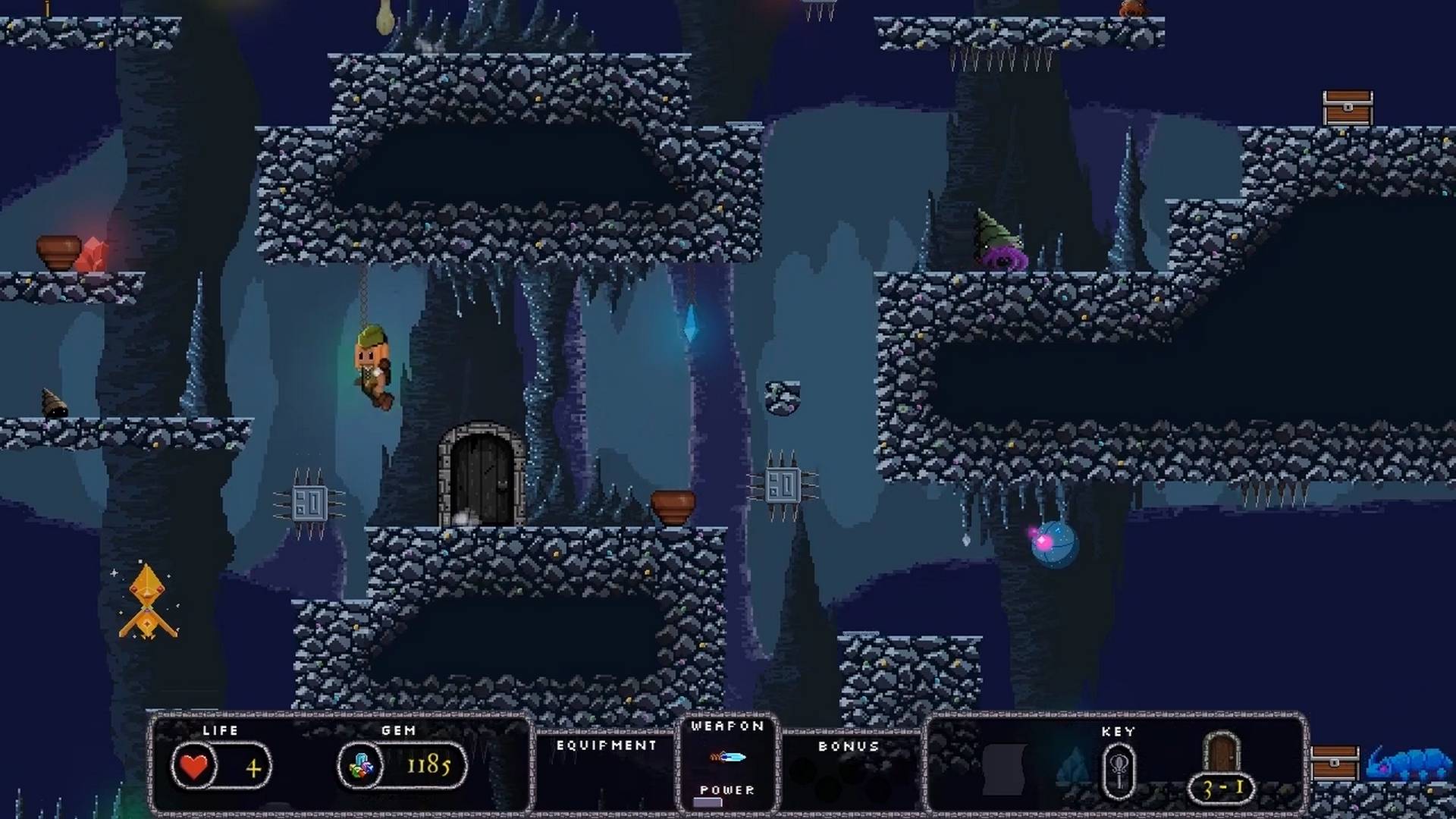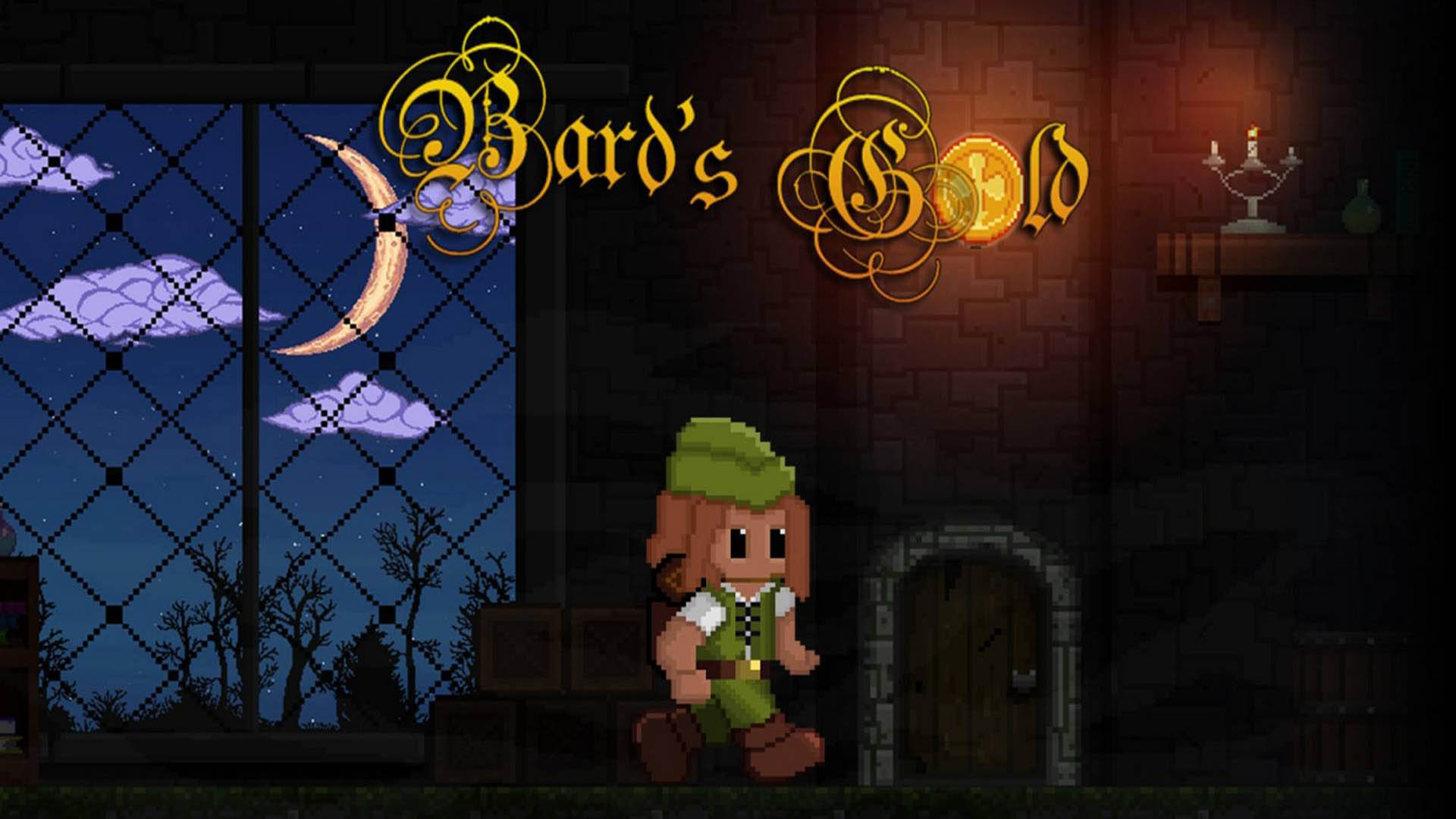Developed By: Pixel Lantern
Published By: Pixel Lantern
Platforms: PS4, Xbox, Nintendo Switch, PC
Reviewed On: Nintendo Switch
The Nintendo Switch is certainly getting no shortage of indie games lately and the latest addition is Bard’s Gold. This game is a challenging platformer that draws inspiration from games of the 90’s such as Wonder Boy, Rick Dangerous and many more. The common thing about all of these platformers is that they are visually charming in their own way but hard as heck when it comes to the gameplay. Bard’s Gold reinforces the term “old school” by bringing these two points while tweaking the formula just a little bit to make the experience a tad bit smoother.
Simply Retro
Right from the start, Bard’s Gold does not hold your hand in any way. There is no form of a tutorial or simple on-screen instructions to guide the player. Even so, the game’s mechanics are simple and it would not take long for anyone to fully grasp. Armed with throwing knives and double jumps, your quest is simple, to search for a Goblin that stole your gold. Interesting thing is that the story setup is told through text description outside the game rather than in the game itself.

As mentioned, simplicity is one of the strengths this game holds. While the premise of the story is almost forgettable and the gameplay mechanics lacks anything new or unique to make it stand out, the retro look and feel are certainly on point. The gameplay here is again very simple, you attack with throwing knives and jump over enemies onto platforms to collect items and gems in each stage. Much like many platforming games, there’s plenty of jumping involved. You jump on and over obstacles, jump to attack and you jump to collect items and gems. The amount of jumping you will be doing acts as a sort of foreshadowing to prepare the player if they will be competent enough to pass through the later stages of the game.
Levels of challenge
There are altogether 4 levels in the game and each level consist of sub-levels with different types of enemies and a unique boss at the end. Each level has differently designed dungeons but they are not procedurally generated. The goal in each level is to search for a key that unlocks a door to the next level whilst grabbing every gem that is available at that level rewarding you with One Life. Each level also has a timer so you can’t take too much time to run or jump around in each level as you will be facing falling fireballs in the stage when the timer runs out which makes the level even harder to navigate.

Attacking enemies that move around can be a challenge due to the pinpoint accuracy that a hit requires. Your basic knife throwing attack goes in a straight line and that’s where your jumping dexterity comes in. Many of the level designs aren’t too complex but many of them do come with different surprises such as falling spikes or flying books- which I initially assumed to be part of the backdrop. The game does give subtle visual cues of these surprises such as the spikes shaking before falling and your character at certain levels will sense an evil presence that is bound to appear. There are also hidden doors and gems throughout each stage and they are revealed via the small glimmers around the level provided you have the Magic Glasses equipped.
In need of weapons

Bard’s Gold doesn’t seem to have a lot of variety when it comes to equipping your character. The throwing knives are the only default arsenal you have, though you can purchase 4 other weapons using the gems you’ve collected. There is the Axe which is stronger but travels at an arching pattern which means can be difficult to hit close range enemies. Next, we have the Chakram which is cost-effective but comes out slow. Many of these weapons do provide diversity when it comes to dealing with enemies archetypes but also feels limiting at the same time. How well you time your jumps and movements is still key to survive each level. I do wish there were more choices in your arsenal rather than throwing weapons. A selection of spells to mix it up by adding for attacking or supporting options can greatly provide alternative means for the player. Considering the premise is based on fantasy and has monsters, having spells or magical elements for the main characters would not be too far fetched.
Three-way Difficulty
Bard’s Gold approach to difficulty is an interesting one. You will be given a choice of three which are Normal, Retro and Rogue-Like. On Normal, you will be given more lives and can gain a generous amount of gems while the pool of random levels are more consistent and familiar whereas Retro is the same but offers less lives and the pool of random levels is expanded but you earn more gems. Furthermore, you can get killed in one hit but you can respawn back at the cost of one Life. These two modes also allow you to bank your gems to further upgrade your characters through spell-books. These spell books are collected in the game and provides benefits such as increasing the number of lives you can carry or the number of gems you pick up. As much as it is a platformer, it also has rogue-like elements which means your progress does keep getting better the more replays you do with further upgrades.

The ‘Rogue-Like’ difficulty on the other hand is considered the hardest of all. This mode changes up the health system. Instead of getting one hit which consumes one Life upon respawn, it will be a per-hit system which means consuming a Life upon getting hit. This mode only allows you to have three Lives and it will be a perma-death. You won’t be able to do any upgrades in this mode. The amount of gems is a lot more and the pool of random levels will be the most expansive providing a more challenging experience.
Worth noting
Even though it seems to be one of the most forgiving and simplest of all rogue-like games, Bard’s Gold does come with some parts that are worth noting. While for the most part everything works as intended, the controls can still be a constant struggle to get used to. For instance, the jump is pressure sensitive. You jump higher by tapping twice or once for a short jump. The feel of the jump isn’t as tight as it should be and at times you would die due to a wrong estimation of your jump. While this problem can be solved through understanding and practicing the controls, it still can be a source of frustration when you trying your best not to consume your lives at the early levels.

While the pixel graphics and soundtrack provide a throwback feel for 90’s games, it does not leave a long lasting impression for the player. The level designs are varied and unique and definitely stood faithful to the retro style, however it is hard to say the same for the character itself. Somehow I can’t seem to put my finger on why I felt the character design seemed out of place in comparison to the whole design of the game. It just felt odd when you begin to look at the game wholly. Furthermore, while the bosses have good designs, their attack patterns aren’t as varied as I would come to expect. Once you notice the small number of attack patterns they have, you will be able to fight through it without too much problems.

As mentioned before, the story of this game was never shown or introduced at all at the start. You will only get a very brief understanding of what were the motives of the main character at the end of the game. While the brief story is barebones, I did the wish the developer is able to add more personality to the main character by having some small cut scenes or even short dialogues to showcase a goal for the character which can also be tied into the uniquely designed worlds. It felt like a missed opportunity that should have been included here. While story elements may not impact much but it does flesh out every aspect of the game in proper and gives a unique identity especially when the gameplay mechanics are already simple as it is.
The Good
- The feel of the 90’s platformer is strong in this one
- Very easy to pick up
- Variety of upgrades to make the game more gradually fun
- Four different worlds that showcases different and unique designs
The Not so Good
- Jump controls can be really challenging to master
- Not much variety in weapons
- No story introduction to know what is going in the game
- Depending on the player, bosses can be too simple to overcome
- Main character design looks too odd
- No memorable soundtrack or game mechanics
Verdict
Bard’s Gold truly brings back the feel of 90’s gaming. It is definitely not the most visually appealing of the whole bunch but it certainly offers solid fun and a decent enough challenge to keep things interesting. While the game mechanics are nothing to shout about, it is still easy to pick up without too much of a hassle. The lack of instructions or tutorials means it encourages players to really experiment with everything so they can remember the mechanics much better. While this game will not be a game changer in the rogue-like genre but it does give the new generation players who have yet to experience a classic game of this type. Bard’s Gold is out now on the Nintendo eShop




